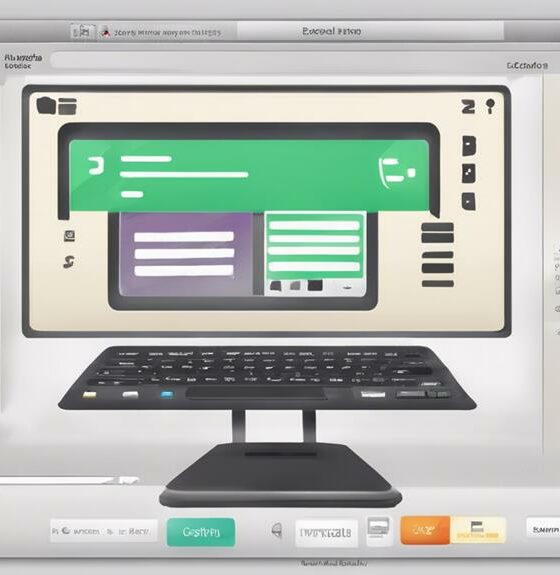Expert Guides
NorFonts Music Font Bundle – Handwritten-Style Music Fonts

NorFonts Music Font Bundle – Handwritten-Style Music Fonts
Notation Central is the place to make the most of the music notation software you use. Now they released a NorFonts Music Font Bundle. NorFonts Music Font Bundle is a bundle of all four NorFonts handwritten-style music fonts.
An incredible bundle of all four NorFonts handwritten-style music fonts. Save 30% by purchasing them all together!
- BopMusic
- LeadSheet
- NorPen
- RealScore
BopMusic– BopMusic is a handwritten music font in a style similar to that of many jazz charts, including a complete script font for text, chord symbols, and hundreds of symbols for jazz and commercial music.

LeadSheet – LeadSheet is a beautiful, bold and clean handwritten music font in a style similar to that of many jazz charts, including a complete script font for text, chord symbols, and hundreds of symbols for jazz and commercial music.

NorPen – NorPen is a modern, robust handwritten music font similar to the Jazz music font and JazzText with many different effects.

RealScore – RealScore is a handwritten music and text font with lots of personality. Nothing else will get you as close to the look and feel of the classic Real Book look as RealScore!

Podcasting
What Essential Podcasting Equipment Do You Need?
On your podcasting journey, discover the essential gear starting with the letter 'O' that will elevate your audio quality and production value.
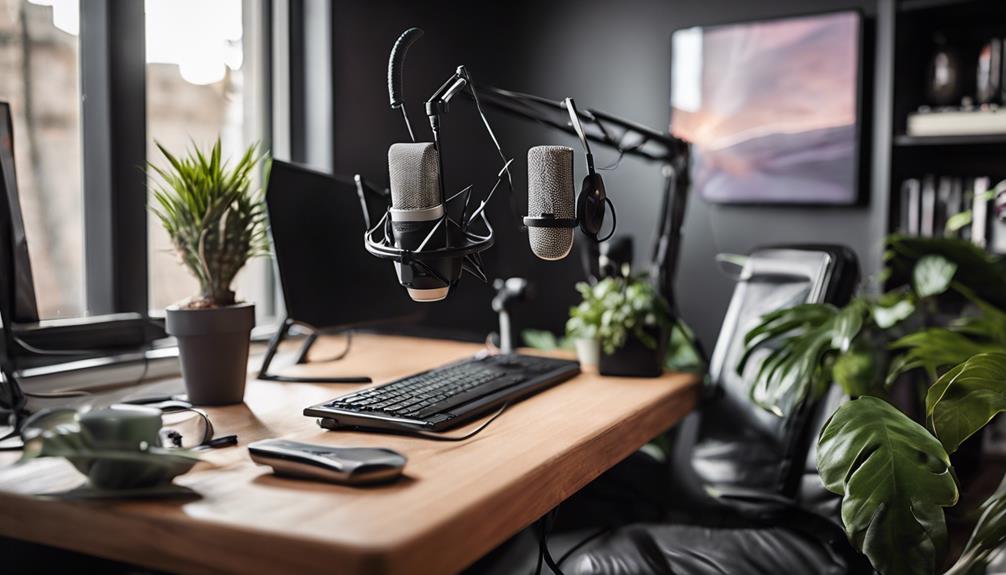
When starting a podcast, essential gear includes microphones (USB for easy use, XLR for top sound), recording software (like Skype for interviews), quality headphones (for clear listening and speaking), a mixer (enhances audio), and acoustical treatments (for studio-like sound). These tools boost production and audio quality, laying the foundation for successful podcasting.
Key Takeaways
- Choose between USB or XLR microphones based on convenience or sound quality.
- Use recording software like Skype, Zoom, Ringr for high-quality audio and editing capabilities.
- Select closed-back headphones for sound isolation and precise volume control.
- Invest in a mixer with multiple channels and preamps for enhanced production quality.
- Implement acoustical treatments like foam tiles and panels for professional audio standards.
Microphones
When starting a podcast, selecting a microphone that suits our needs and budget is essential. USB microphones are user-friendly options, perfect for beginners diving into podcasting. These mics plug directly into our laptop, eliminating the need for additional gear.
On the other hand, XLR microphones offer superior sound quality, ideal for those seeking professional-grade recordings. However, they require extra equipment like audio interfaces. To enhance our audio quality, a pop filter is a must-have accessory. It helps reduce plosive sounds, ensuring our recordings are clear and crisp.
For ideal positioning and convenience during recording sessions, investing in a microphone arm can greatly improve our setup. When choosing a microphone, ensuring compatibility with our laptop is important. This compatibility ensures seamless integration and prevents any technical hiccups that could disrupt our podcasting workflow.
Recording Software
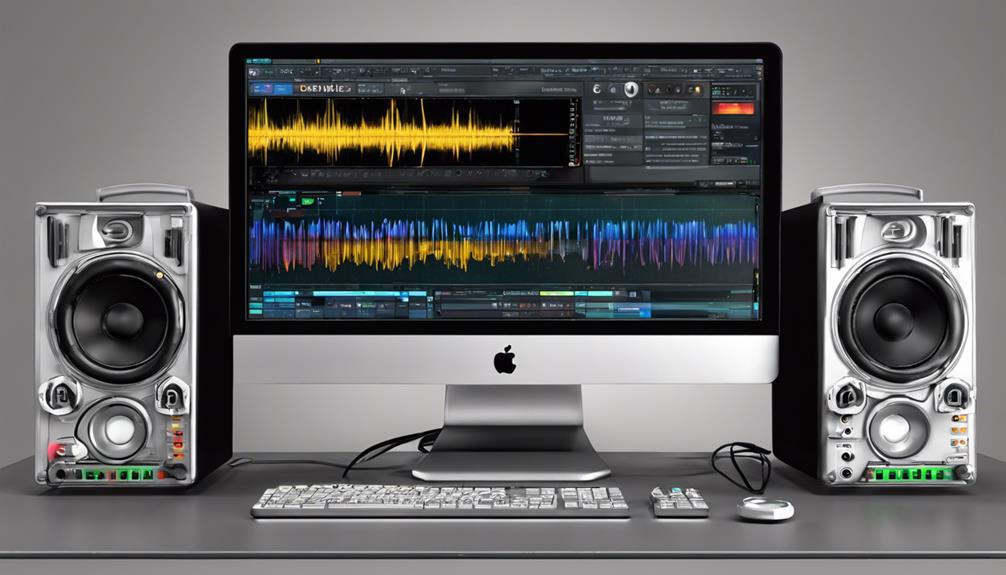
Selecting the appropriate recording software is essential for ensuring efficient and high-quality podcast production. When looking for the right audio recording software, consider options that offer remote podcast creation, collaboration with guests, and professional audio production. Some popular choices in the market include:
- Skype: Known for its usability and widespread adoption in remote podcast interviews.
- Zoom: Offers excellent audio quality and the ability to record separate audio tracks for each participant.
- Ringr: Ideal for capturing high-quality audio from remote guests with minimal background noise.
- Squadcast, Riverside: Both platforms are dedicated to providing editing capabilities and tools for producing high-quality podcasts seamlessly.
With these innovative recording software tools, podcasters can enhance their production quality, engage with guests remotely, and streamline the editing process to deliver compelling content to their audience.
Headphones
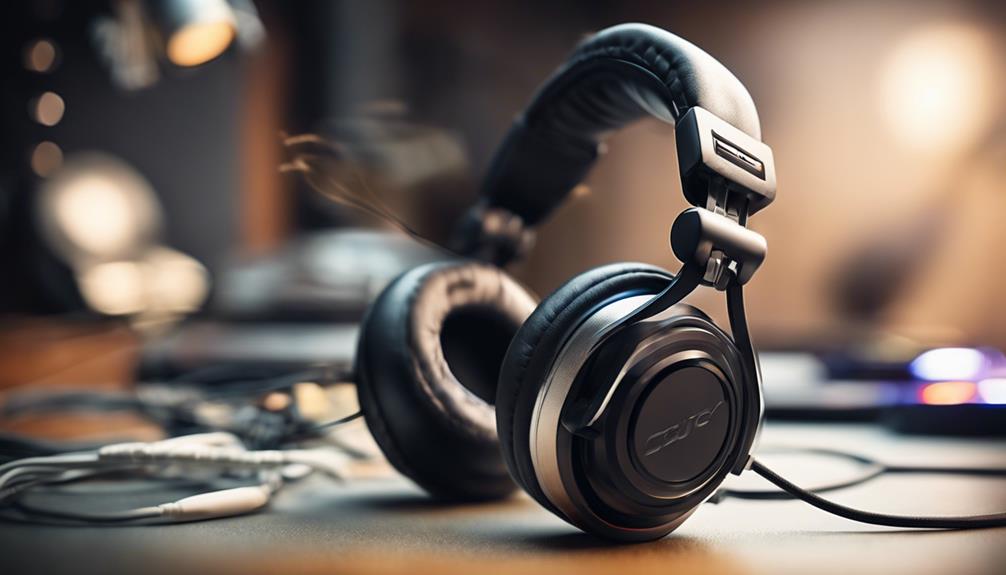
To optimize podcast recordings, incorporating suitable headphones is essential for maintaining quality control and preventing feedback.
When selecting headphones for podcasting, consider factors such as frequency response and sound isolation to guarantee clear and accurate sound monitoring.
Closed-back headphones are recommended as they help minimize sound leakage, keeping the audio focused and preventing distractions. These headphones not only aid in quality control but also enhance microphone technique by providing a more accurate representation of the recording.
By using headphones with good sound isolation, hosts can prevent plosive sounds and other unwanted noises, resulting in cleaner podcast recordings.
Additionally, clearer voice monitoring allows hosts to adjust their speaking volume and tone effectively, leading to a more professional and engaging podcast.
Therefore, investing in the right headphones is crucial for podcasters looking to elevate the quality of their content and provide a more immersive listening experience for their audience.
Mixer
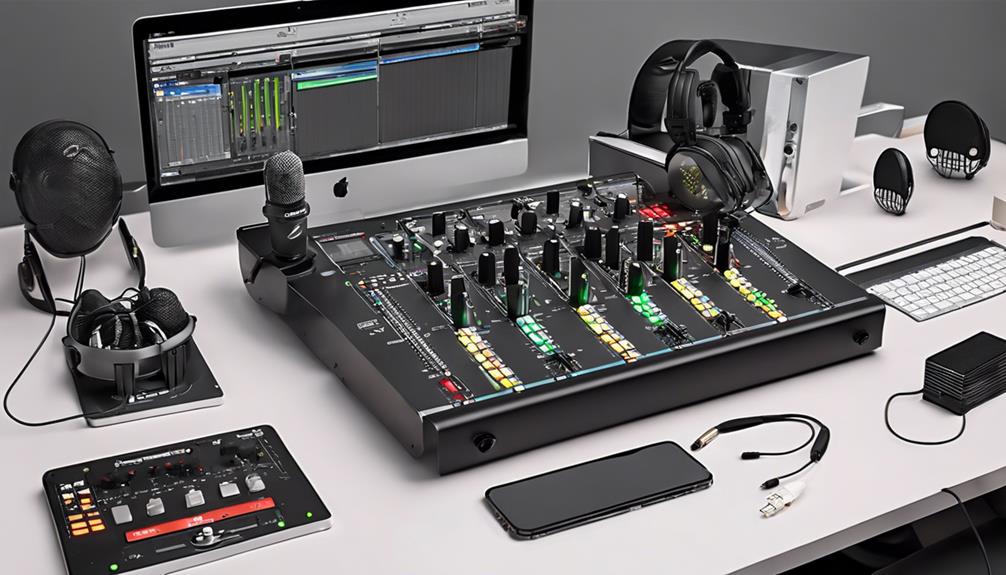
For podcasters seeking to enhance their audio quality and production capabilities, incorporating a mixer is an essential step in optimizing their content creation process. When considering mixers for your podcasting setup, here are some key features to look for:
- Multiple Channels: Choose a mixer that offers multiple channels to accommodate various audio sources simultaneously.
- Preamps: Having built-in preamps can help boost the quality of your XLR microphones and other audio inputs.
- Audio Interfaces: Some mixers can double as audio interfaces, simplifying your setup and offering more control over inputs and outputs.
- Production Quality: Mixers play a vital role in improving production quality, especially for podcasts with remote guest calls or live music features.
Acoustical Treatments
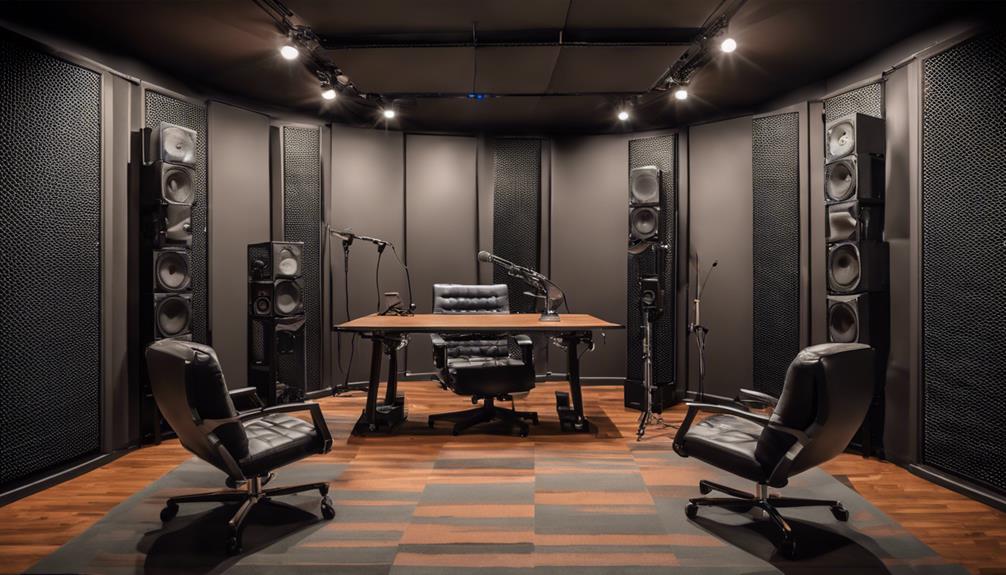
When looking to optimize podcast audio quality and reduce unwanted echoes, acoustical treatments become pivotal in creating a professional recording environment. These soundproofing solutions, such as foam tiles and carpeting, play an essential role in enhancing sound quality.
Acoustic panels strategically placed on walls and ceilings can further improve audio clarity and eliminate reverberations. Maintaining professional audio standards in podcast recordings is reliant on effective acoustical treatments.
Consideration of Class A acoustic tiles, foam windscreens, and windjammers is key to achieving excellent sound quality. By investing in these acoustical treatments, podcasters can create a controlled environment that minimizes echoes and ensures a crisp, professional sound output.
Whether it's setting up a home studio or enhancing an existing recording space, incorporating these soundproofing elements is essential for producing high-quality podcasts that captivate listeners.
Frequently Asked Questions
What Equipment Do I Need for a Podcast?
When starting a podcast, you'll need essential equipment like a computer, microphone, headphones, pop filter, and recording software.
A laptop is great for portability and processing power. Microphones come in USB and XLR types, with condenser mics offering clearer sound.
Pop filters help remove plosive sounds. Make sure to use a microphone stand for ideal positioning.
These tools are essential for quality podcast recordings.
What Equipment Do I Need to Be a Podcast Guest?
We need a good quality microphone and headphones for clear audio and communication.
Using a pop filter or windscreen can improve audio quality by reducing unwanted sounds.
A stable internet connection is vital for remote interviews.
Familiarizing ourselves with the podcast's topic and format is essential.
What Is the Most Important Piece of Equipment if You Are Making a Podcast?
When creating a podcast, the most essential piece of equipment is a high-quality microphone. It guarantees clear and professional audio, capturing voices with minimal background noise. Investing in a good microphone greatly enhances the overall quality of episodes.
Microphones come in various types like USB and XLR, each offering unique sound quality and versatility. Using a dedicated microphone rather than built-in computer mics enhances the production value of your recordings.
What Are Podcasters Needs?
When podcasting, our needs include a reliable computer for recording, editing, and publishing audio files. A quality microphone is essential for capturing clear sound, while pop filters and windscreens help reduce plosive sounds.
Microphone stands guarantee proper positioning for hosts and guests, maintaining consistent audio quality. An audio interface is vital for converting analog signals to digital format, especially when using multiple microphones.
Conclusion
To sum up, having the right podcasting equipment is essential for producing high-quality audio content. Just like a painter needs their brushes and canvas, a podcaster needs their microphones and recording software to create their masterpiece.
Investing in quality equipment can make a significant difference in the final product, ensuring that your podcast sounds professional and engaging. So, don't skimp on the essentials – equip yourself with the tools you need to make your podcast shine.
Podcasting
How Much Can You Make Podcasting?
Hang on to discover how podcasters earn from $500 to $900 per episode and the potential for financial success in the podcasting industry.

Podcasters typically earn $500 to $900 per episode with around 10,000 downloads. Earnings depend on factors like audience size and engagement. Monetization strategies include sponsorships, ads, and platforms like Patreon. Providing valuable content and engaging the audience consistently can boost earnings. Top podcasters like Joe Rogan and Karen Kilgariff & Georgia Hardstark make millions, showing the potential for financial success in podcasting. If interested in learning more about maximizing your podcast earnings, check out detailed insights and strategies from successful podcasters in the industry.
Key Takeaways
- Podcasters typically earn $500 to $900 per episode with 10,000 downloads.
- Top podcasters like Joe Rogan and Karen Kilgariff earn millions annually.
- Income sources include ads, sponsorships, Patreon, and exclusive deals.
- Strategies like audience engagement and valuable content enhance earnings.
- Various monetization approaches and revenue streams contribute to income growth.
Average Podcasters' Earnings
When starting out, podcasters typically earn between $500 to $900 per episode with around 10,000 downloads. These earnings can vary based on factors such as audience size, engagement levels, and the podcast's niche. To increase earnings, podcasters often implement various monetization strategies like sponsorships, ads, and platforms such as Patreon. By consistently delivering valuable content and fostering audience engagement, podcasters can attract more listeners and potentially increase their earnings over time.
Understanding the average earnings of podcasters is essential for those looking to monetize their podcasts effectively. By recognizing the potential income that can be generated with a moderate audience size, podcasters can tailor their content and monetization strategies to maximize their earnings. While top-earning podcasters like Joe Rogan and others make millions annually, the average podcaster can still achieve a respectable income by focusing on building a loyal audience and exploring different monetization avenues such as sponsorships and ads.
Top Earning Podcasters
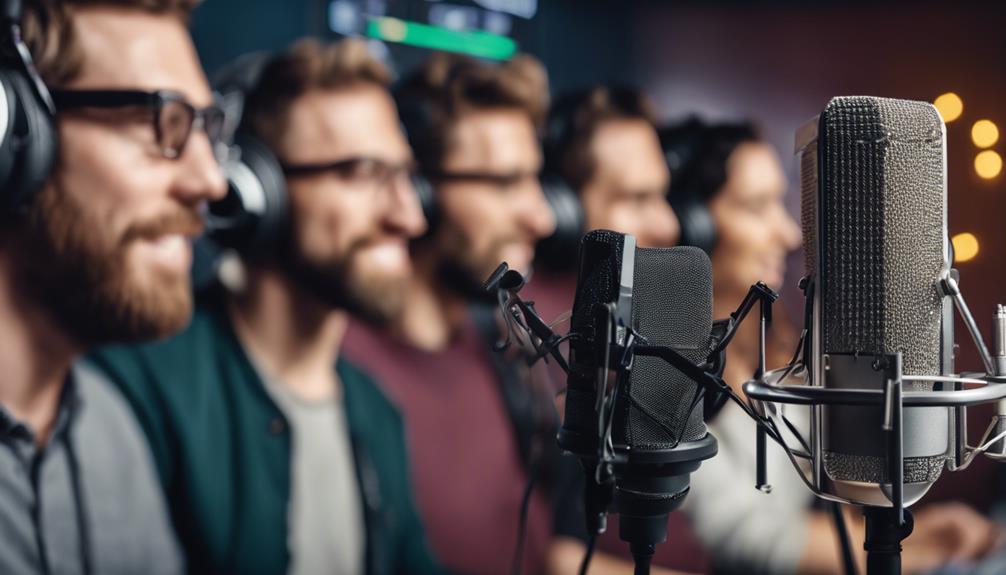
Top earning podcasters like Joe Rogan and Karen Kilgariff & Georgia Hardstark demonstrate the impressive income potential in the podcasting industry. Their success highlights the various sources of income available to podcasters, from advertising to exclusive deals.
These top earners also showcase the significant room for growth and expansion within the podcasting landscape.
High Earning Podcasters
Among the podcasters who have achieved significant financial success, Joe Rogan's exclusive Spotify deal stands out as one of the most lucrative, valued at a minimum of $200 million. Karen Kilgariff and Georgia Hardstark from 'My Favorite Murder' have accumulated a net worth of $40 million, emphasizing the substantial earnings potential in podcasting. Dax Shepard, hosting 'Shepard Armchair Expert,' earns $9 million annually, showcasing the high income opportunities available. Bill Simmons, with 'The Bill Simmons Podcast,' made $7 million last year, highlighting the profitability of successful podcasting ventures. Additionally, Chapo Trap House generates approximately $2 million each year, proving that even podcasts with controversial content can find diverse ways to monetize effectively.
| Podcaster | Annual Earnings | Notable Podcast |
|---|---|---|
| Joe Rogan | $200 million | Spotify Exclusive Deal |
| Karen Kilgariff | $40 million | My Favorite Murder |
| Dax Shepard | $9 million | Shepard Armchair Expert |
| Bill Simmons | $7 million | The Bill Simmons Podcast |
Income Sources Breakdown
Exploring the earning sources of top podcasters reveals the diverse revenue streams that contribute to their impressive incomes. Podcast advertising, sponsorships, affiliate marketing, listener donations, exclusive content, ad revenue, and direct support all play crucial roles in their monetization strategy.
Joe Rogan's exclusive Spotify deal exemplifies the massive income potential, while Dax Shepard and Bill Simmons showcase the substantial earnings from successful podcasts.
Chapo Trap House's controversial content demonstrates the various monetization approaches available. Tim Dillon's yearly earnings highlight the varying income levels within the podcasting industry.
These top podcasters leverage a combination of revenue streams to maximize their income potential, showing the lucrative opportunities available in the podcasting landscape.
Potential for Growth
With the podcasting industry witnessing exponential growth, notable earners like Joe Rogan and Karen Kilgariff & Georgia Hardstark are emblematic of the immense potential for financial success in this digital landscape. Top podcasters such as Dax Shepard, Bill Simmons, and Chapo Trap House also demonstrate the substantial earnings achievable in this industry.
Unique monetization strategies and successful audience engagement tactics have paved the way for significant income growth, as seen with Tim Dillon and Ramit Sethi. These top earners highlight the diverse opportunities for financial success through strategic partnerships and innovative approaches to content creation.
The success of these podcasters showcases the vast potential for growth and income in the podcasting industry, offering insights into the various pathways to achieving financial success through podcasting.
Starting a Successful Podcast
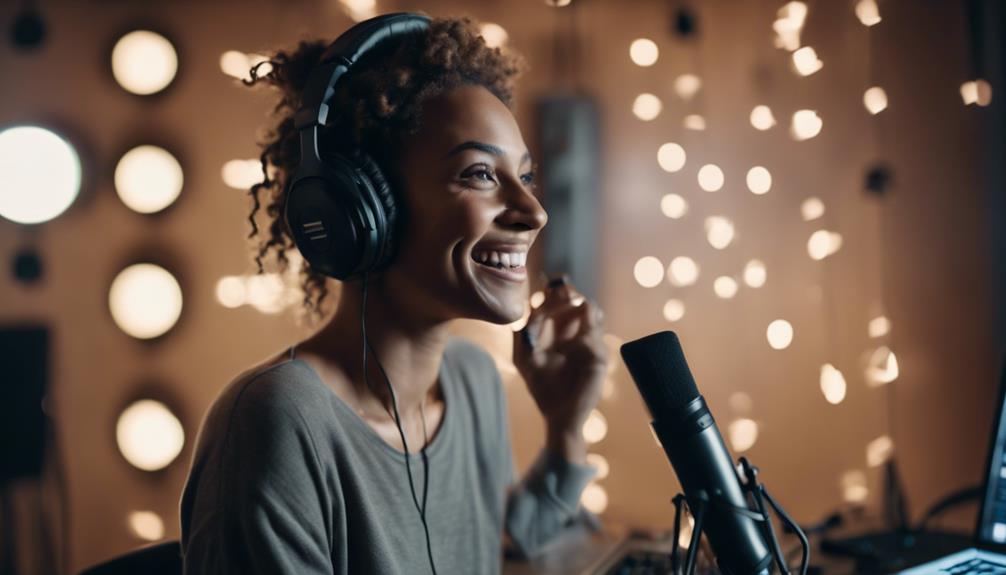
To kickstart a successful podcast, defining a clear concept based on our interests and the needs of our audience is essential. Investing in quality equipment, such as microphones and editing software, guarantees professional sound quality that resonates with listeners.
Planning engaging content and maintaining a consistent schedule are key factors in attracting and retaining a loyal audience. Audience engagement through social media interactions, listener feedback, and active participation can further enhance the podcast's reach and impact.
Additionally, promoting the podcast through various channels is essential to reaching a wider audience and increasing visibility in the competitive podcasting landscape. By aligning our podcast concept with audience needs, investing in high-quality equipment, creating compelling content, engaging with listeners, and actively promoting the podcast, we can lay a solid foundation for starting a successful podcast journey.
Consistency, quality, and audience-centric approaches are essential elements in establishing a podcast that stands out and resonates with a diverse audience.
Monetization Strategies
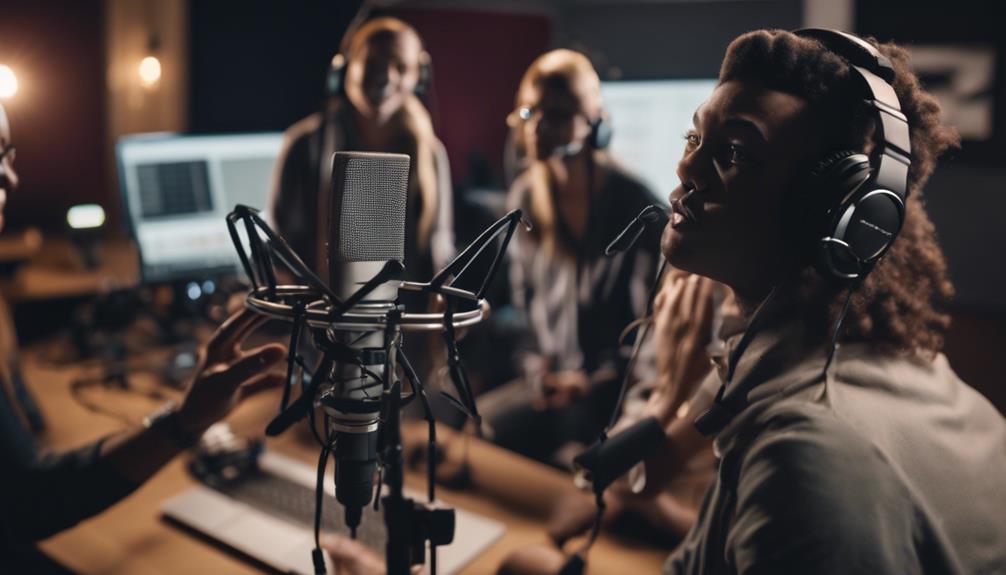
When it comes to monetizing a podcast, there are various strategies to explore. Sponsorship opportunities, affiliate marketing, and product sales are common ways podcasters generate income.
Sponsorship Opportunities
How can podcasters maximize their earnings through strategic sponsorship opportunities?
By tapping into the vast potential of podcast advertising, podcasters can secure lucrative sponsorship deals that greatly impact their earnings per episode. With average CPM rates for a 60-second ad at $25, understanding the dynamics of sponsorship opportunities becomes essential in maximizing earnings.
Top podcasts like The Joe Rogan Experience exemplify the success achievable through well-crafted sponsorship deals. Platforms such as Ad Results Media, Adopter Media, and True Native Media provide avenues for podcasters to explore various ad placement options, enhancing their revenue streams.
Affiliate Marketing
Exploring affiliate marketing as a monetization strategy allows podcasters to tap into additional revenue streams beyond traditional sponsorships and ads. The average affiliate marketing commissions for podcasters typically range from 5% to 30% per sale, presenting lucrative opportunities.
By joining popular affiliate programs such as Audible, podcasters can earn commissions on sign-ups, enhancing their income potential. To succeed in affiliate marketing, clear affiliate links and effective promotion strategies are essential.
This approach not only provides podcasters with a passive income stream based on listener purchases but also helps diversify their revenue streams. Incorporating affiliate marketing alongside sponsorships and ads can create a more sustainable and profitable monetization strategy for podcasters looking to maximize their earnings.
Product Sales
To maximize revenue potential, podcasters can leverage product sales as a complementary monetization strategy alongside affiliate marketing and sponsorships, offering listeners merchandise tied to the podcast's brand and content. Selling branded clothing, accessories, or niche-related products can deepen listener connections and enhance audience engagement. Merchandise sales typically yield an average net margin of 9.63%, providing a sustainable revenue stream for podcasters. By diversifying income streams with product sales, podcasters not only boost their earnings but also strengthen audience loyalty. This strategy works well in conjunction with sponsorships, ads, and premium content, contributing to overall revenue growth.
| Key Points | |
|---|---|
| Net Margin | 9.63% |
| Sustainable Revenue | Yes |
| Audience Engagement | Enhanced |
Maximizing Revenue
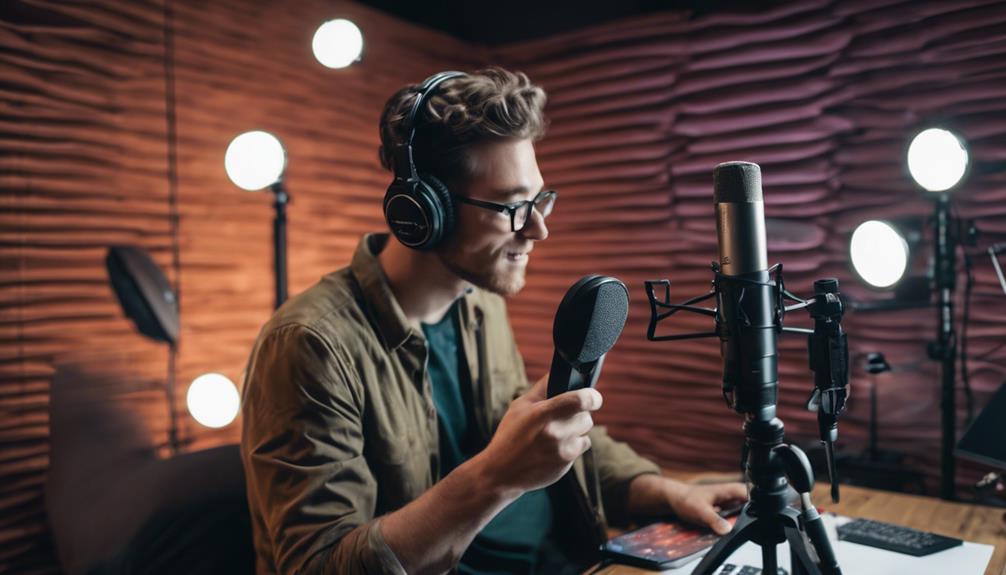
Maximizing revenue as a podcaster involves strategically diversifying income streams and engaging with your audience to build loyalty. By incorporating various revenue streams such as sponsorships, affiliate marketing, merchandise sales, premium content, crowdfunding, donations, book sales, online courses, and public speaking engagements, podcasters can greatly boost their earnings. Successful podcasters like Joe Rogan, Bill Simmons, and Dax Shepard have demonstrated the potential for substantial annual income by utilizing these strategies effectively.
To maximize revenue potential, it's essential to focus on building a loyal audience base through engaging content and consistent delivery. Additionally, implementing effective marketing strategies, exploring creator collaborations, and offering services tailored to the audience's needs can further increase podcasting income. By combining these approaches with a commitment to high-quality content and listener interaction, podcasters can open up new opportunities for revenue growth in an ever-evolving digital landscape.
Tools for Podcast Monetization
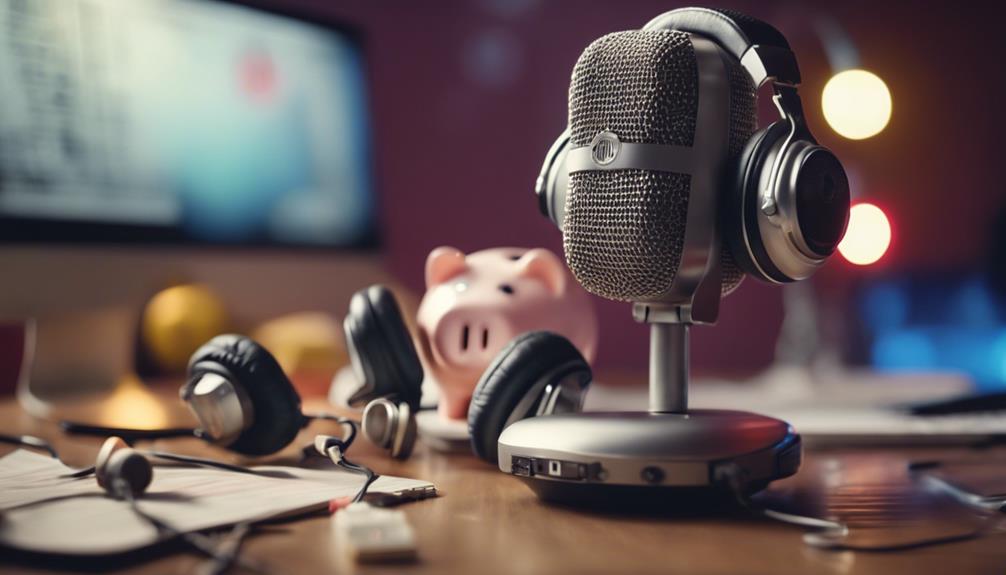
Podcast monetization can be enhanced through various tools and platforms that offer opportunities for ads, sponsorships, and collaborations.
- Spotify for Podcasters: Utilize insights and features to optimize revenue streams and reach a broader audience.
- Members-only feeds: Offer exclusive content to subscribers for increased monetization potential and loyalty.
- Email lists: Engage with listeners directly, promote products/services, and drive monetization through targeted marketing.
- Syndication on various apps: Expand reach and monetization opportunities by distributing podcasts on multiple platforms.
- Ad space on websites and radio stations: Increase exposure and revenue by selling ad space on websites and partnering with radio stations for ad placements.
Frequently Asked Questions
How Much Money Can I Make on a Podcast?
When it comes to podcasting, the potential income varies widely. Factors like audience size, niche, and monetization strategies play a significant role in determining earnings.
Successful podcasters can earn anywhere from a few hundred dollars to millions per episode. Understanding your audience and consistently delivering valuable content are essential for maximizing podcast income.
With dedication and strategic planning, the podcasting landscape offers a range of opportunities for financial success.
Is Owning a Podcast Profitable?
Owning a podcast can be profitable if managed well. By consistently growing our audience, creating high-quality content, and implementing effective monetization strategies, we can boost profitability.
Diversifying income streams through sponsorships, ads, and affiliate sales can further enhance our earnings. Successful podcasters like Joe Rogan and others showcase the income potential of this field.
With dedication and innovation, owning a podcast can indeed lead to financial success.
Who Is Highest Paid Podcaster?
We can confirm that Joe Rogan stands as the highest-paid podcaster, securing an exclusive Spotify deal valued at a minimum of $200 million.
His significant earnings solidify his position atop the podcasting industry.
How Many Views Do You Need to Make Money on a Podcast?
To make money on a podcast, one needs a solid audience base. Monetization starts around 1,000 downloads per episode, for methods like affiliate marketing or listener donations.
Sponsorships and ads often require 5,000 to 10,000 downloads. Higher numbers, like 50,000 per episode, open doors to premium sponsorships. The exact views needed depend on the monetization method, audience engagement, and content niche.
It's all about building that loyal following!
Conclusion
To sum up, podcasting has the potential to be a lucrative venture for those willing to put in the time and effort. As the saying goes, 'the sky's the limit' when it comes to earning potential in this industry.
With the right strategies and dedication, you can turn your podcast into a profitable source of income.
So why wait? Start podcasting today and see where it takes you!
Expert Guides
How to Discover Free to Use Music
Tune into a world of free-to-use music across various platforms, enhancing your projects with unlimited creative possibilities.
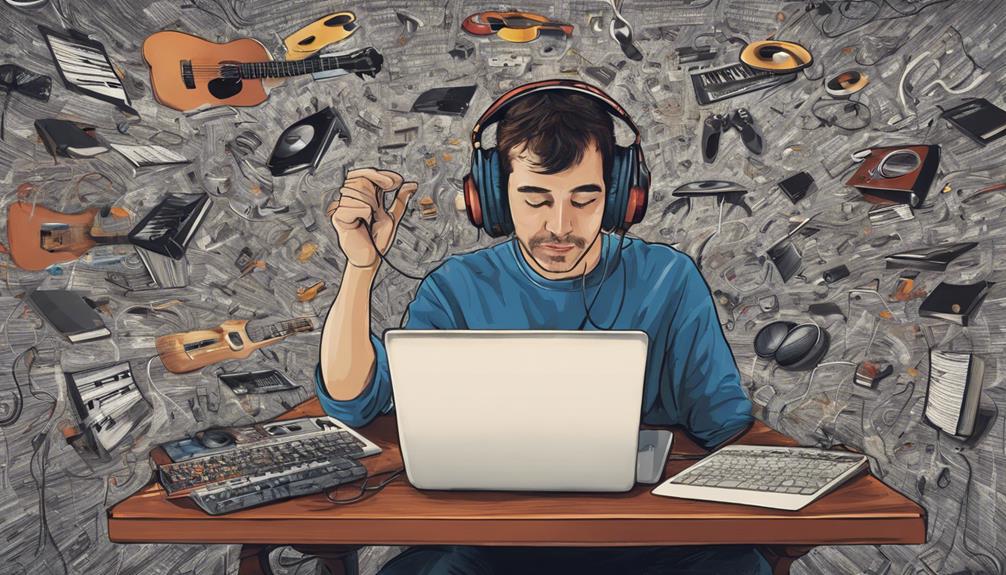
When looking for free-to-use music, explore platforms like YouTube Audio Library, Free Music Archive, Jamendo, and more. These sites offer an array of royalty-free music, perfect for various projects. Sites such as SoundCloud and Bandcamp also provide extensive libraries with Creative Commons-licensed tracks and support for artists. Royalty-free music guarantees budget-friendly options and flexibility. Discover diverse genres and styles through free music libraries that cater to different creative needs. Remember, tapping into these resources can enrich your projects with high-quality and varied musical choices. More insights await further exploration of these platforms.
Key Takeaways
- Explore platforms like YouTube Audio Library for a wide selection of royalty-free music.
- Check out sites like Jamendo and Free Music Archive for Creative Commons-licensed music.
- Consider using ccMixter for collaborative projects and Incompetech for diverse genres.
- Utilize resources like Musopen for orchestral pieces and Bensound for videos and animations.
- Look into SoundCloud and Bandcamp for a vast collection of free music tracks.
Top Platforms for Free Music Discovery
When searching for free music to use in projects, we often turn to top platforms that cater to diverse musical needs. Platforms like YouTube Audio Library, Free Music Archive, ccMixter, Incompetech, Jamendo, Musopen, and Bensound offer a plethora of options for creators looking for high-quality music without breaking the bank.
YouTube Audio Library provides a vast collection of royalty-free music suitable for various projects, while Creative Commons-licensed music can be found on websites like Free Music Archive, Jamendo, and Musopen. For those seeking collaborative works, ccMixter is an excellent choice, while Incompetech offers a wide range of genres to explore.
Musopen caters to those in need of orchestral pieces, and Bensound provides music perfect for videos, websites, and animations. These platforms not only provide free music but also ensure that creators have access to a diverse selection to enhance their projects with innovative soundtracks.
Best Sites for Free Music Downloads
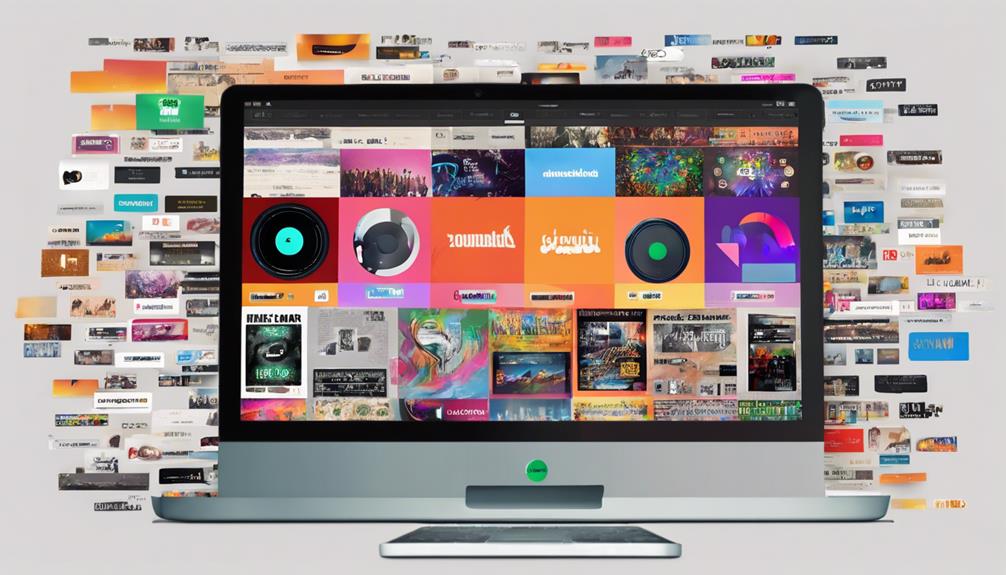
Among the plethora of platforms offering free music downloads, several stand out for their extensive catalogs and user-friendly interfaces. When looking for free music clips or background music for videos, these sites provide a wide array of options for artists and creators. Here are some of the best sites for free music downloads:
| Site | License Types | Features |
|---|---|---|
| Jamendo | Creative Commons Music | Over 250,000 tracks available |
| SoundCloud | Creative Commons Music | 265 million songs globally |
| Freeplay Music | Creative Commons License | 50,000 tracks for non-commercial use |
| Bandcamp | Free Downloads | Supports artists with donations |
These platforms offer a mix of public domain and royalty-free music, catering to both personal and commercial use. Users can easily find music through search bars and explore diverse genres. Whether you need background music for a video or simply enjoy discovering new artists, these sites provide a wealth of options for free music downloads.
Exploring Royalty-Free Music Options
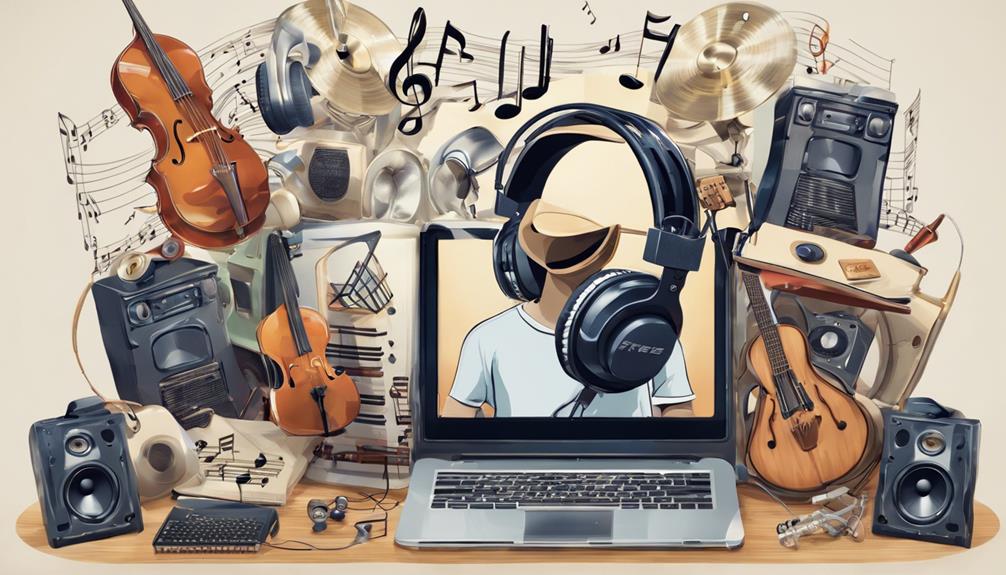
Let's explore the diverse world of royalty-free music options available for creators seeking affordable and versatile soundtracks. Royalty-free tracks offer a budget-friendly solution for those looking to enhance their projects without recurring fees. These tracks allow for unlimited use after a one-time payment or subscription, providing financial predictability and flexibility for both commercial and personal endeavors.
Various platforms host music libraries with a wide range of genres to cater to different project needs. When searching for royalty-free music, consider exploring Creative Commons content, which often supports independent artists and offers free to use music for commercial purposes. This type of music licensing ensures that creators can find free music while respecting copyright laws.
Additionally, free stock music libraries can be a valuable resource for discovering high-quality tracks without breaking the bank. By utilizing these royalty-free options, creators can enhance their content while staying within their budget constraints.
Finding Free Music for Creative Projects

In our quest to discover free music for creative projects, we can explore a multitude of platforms offering a diverse selection of tracks. Websites like ccMixter, Incompetech, and Jamendo provide an array of free music options ideal for enhancing creative projects. Creative Commons licenses on platforms such as Free Music Archive and SoundCloud grant access to thousands of songs for non-commercial use, catering to artists seeking music for their projects. Additionally, artists on platforms like Bandcamp and Musopen share their music for free or accept donations, making it convenient for creators to find suitable music for their creative ventures.
Free music libraries like Musopen and AudioNautix offer a wide range of genres and styles to meet various creative needs, ensuring that creators can find the perfect soundtrack for their projects. Furthermore, platforms like YouTube Audio Library and Bensound provide free music options, adding another dimension to the music choices available for enhancing creative endeavors. Whether it's background music for videos or soundtracks for artistic projects, these platforms offer a treasure trove of free music for creative projects.
Utilizing Resources for Free Music

We can maximize the benefits of free music resources by exploring a variety of platforms that cater to different creative needs. Websites like ccMixter, Jamendo, and Musopen offer extensive libraries of Creative Commons-licensed music, providing a wide range of genres for projects. The YouTube Audio Library, with its vast collection of free music, is another valuable resource for content creators looking for licensed music. SoundCloud, hosting millions of songs, includes a mix of copyrighted and Creative Commons tracks, offering a diverse selection.
Moreover, for those seeking public domain music, platforms like Archive.org are ideal, as they provide music free from copyright restrictions for personal or commercial use. Indie artists on platforms such as Bandcamp and HearThis.at contribute to the pool of free music by sharing their creations either for free or through donations, fostering a community-driven approach to music sharing. By tapping into these resources, creators can access a wealth of free music to enhance their projects and explore new creative possibilities.
Frequently Asked Questions
How Do I Know if My Music Is Copyright Free?
When confirming if music is copyright-free, there are several key steps to follow:
- Check for a Creative Commons license, which indicates specific usage conditions.
- Look for Public Domain music, which is free from copyright restrictions.
- Verify if the music is labeled as Royalty-Free to avoid recurring fees.
- Confirm the platform's licensing terms for commercial use.
- Make sure clear guidelines on crediting the composer are provided.
These steps help us identify if music is copyright-free.
How Do I Make Sure My Song Is Copyright Free?
To guarantee our song is copyright free, we need to verify for Creative Commons or Public Domain licensing. It's essential to confirm specific licensing terms to avoid any copyright issues.
Look for songs with CC0 or CC BY licenses for legal use. Remember, even copyright-free songs may require proper attribution.
Steer clear of songs with All Rights Reserved or unclear licensing terms to prevent copyright infringement. Always double-check the licensing terms for peace of mind.
How Can I Use Music Without Copyright?
We can use music without copyright restrictions by understanding different types of licenses. Creative Commons, public domain, and royalty-free music offer legal ways to access music for various projects. By following specific usage terms and crediting composers or artists, we guarantee ethical and legal compliance.
Public domain music allows for remixing and sharing without legal consequences, while royalty-free music offers cost-effective options without recurring fees. Choosing the right license to use music freely is crucial.
How Can I Get Music Without Paying?
When seeking music without payment, explore platforms like ccMixter, Incompetech, and YouTube Audio Library for free-to-use tracks. These sites offer a plethora of Creative Commons-licensed music suitable for various projects.
Additionally, sites like Free Music Archive, Jamendo, and Musopen provide access to a wide range of music for free use. Engaging with communities on SoundCloud, Bandcamp, and Free Music Archive can lead to discovering and downloading free music shared by independent artists and creators.
Conclusion
To sum up, discovering free-to-use music can be a fun and rewarding experience. By exploring various platforms, sites, and resources, you can find the perfect soundtrack for your creative projects without breaking the bank.
Remember to check for royalty-free options to avoid any copyright issues. So go ahead, immerse yourself in the world of free music and let your creativity soar without any financial constraints.
Happy searching!
-
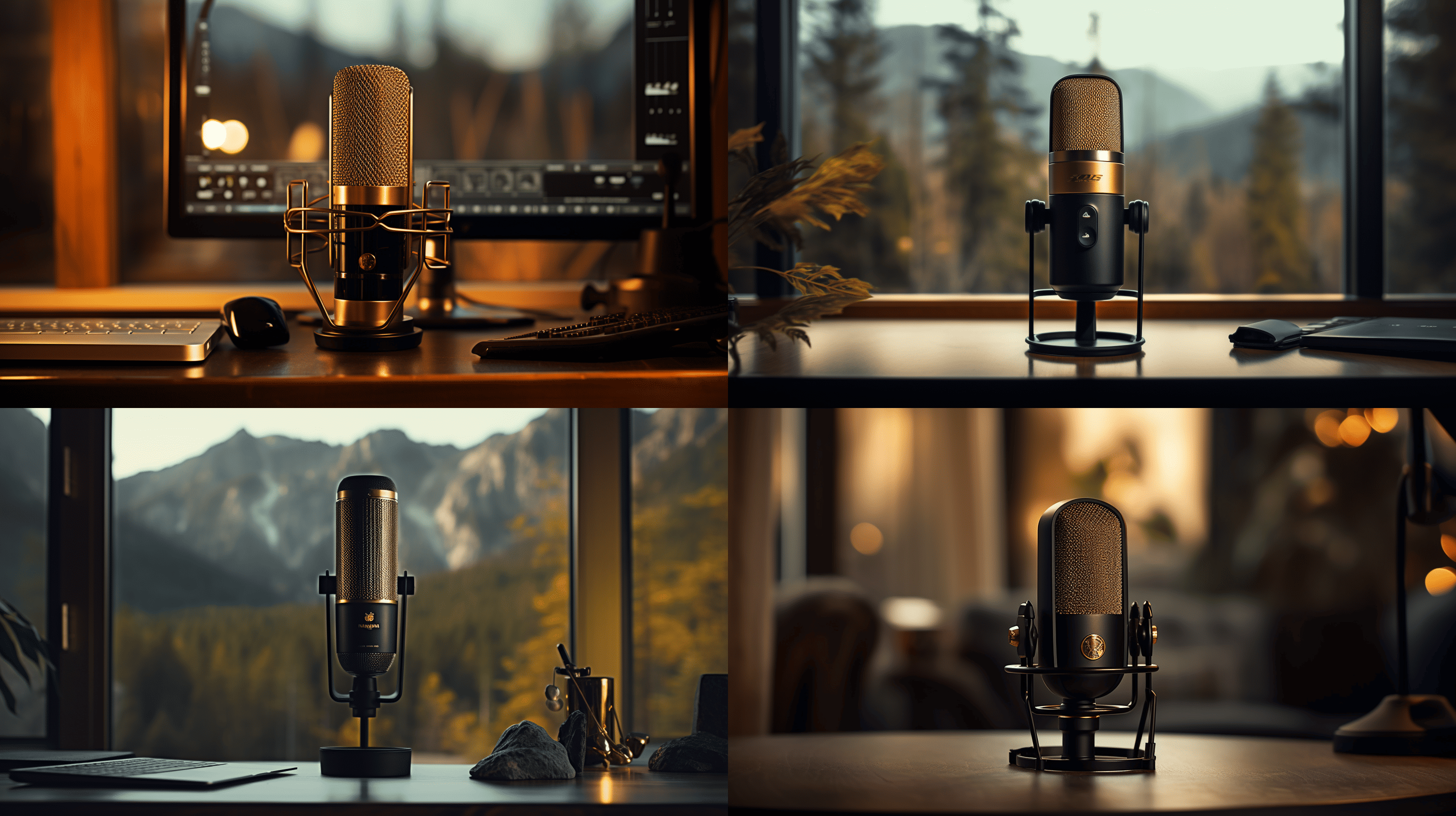
 Microphone1 week ago
Microphone1 week agoUnleash Your Inner Podcaster: Discover the Best Microphone for Crisp, Clear Audio
-

 Music Theory2 weeks ago
Music Theory2 weeks agoUnlocking Nature’s Harmony: The Power of 432 Hz Frequency in Sound & Music for Enhanced Living and Well-Being
-

 Sound Design2 weeks ago
Sound Design2 weeks agoWhat Is the Difference Between a Sound Engineer and A Sound Designer?
-

 Native Instruments Kontakt2 weeks ago
Native Instruments Kontakt2 weeks agoVOCAL AI – Animated Intelligence: The Ultimate Vocal Playground
-

 Sound Design2 weeks ago
Sound Design2 weeks agoWhy Sound Engineer
-
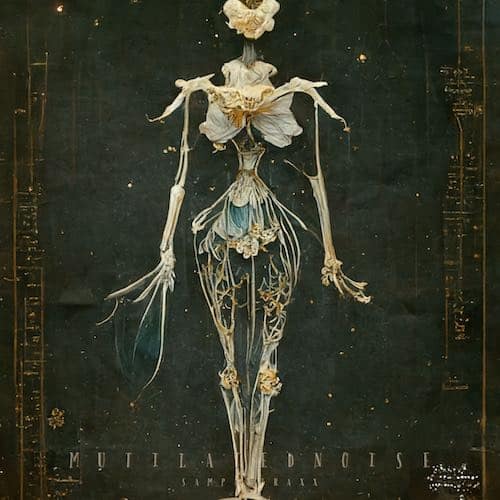
 Composing1 week ago
Composing1 week agoMUTILATED NOISE by SampleTraxx: The Next Generation Sound Collection
-

 Expert Guides2 weeks ago
Expert Guides2 weeks agoHow Do You Become a Sound Designer
-

 Expert Guides2 weeks ago
Expert Guides2 weeks agoHow to Become a Sound Designer for Film




